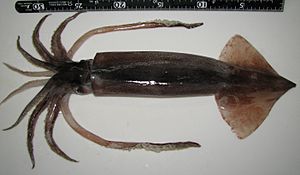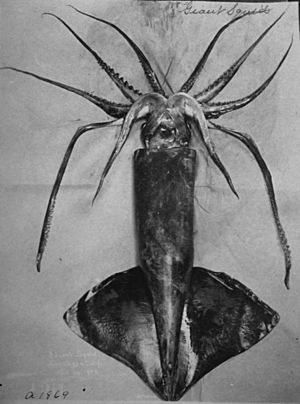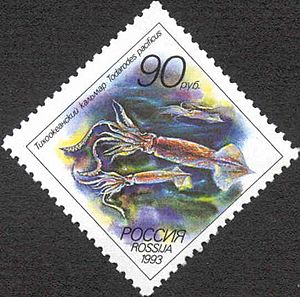Japanese flying squid facts for kids
Quick facts for kids Japanese flying squid |
|
|---|---|
 |
|
| Todarodes pacificus (dorsal view) | |
| Conservation status | |
| Scientific classification | |
| Synonyms | |
|
The Japanese flying squid is also known as the Japanese common squid or Pacific flying squid. Its scientific name is Todarodes pacificus. This amazing animal is a type of squid from the Ommastrephidae family. It lives in the northern Pacific Ocean. You can find it near Japan, along the coasts of China and Russia. It also spreads across the Bering Strait to Alaska and Canada. Sometimes, these squids gather in the central part of Vietnam.
Contents
What Does the Japanese Flying Squid Look Like?
Adult Japanese flying squids have several cool features. Their body, called the mantle, holds their organs. They have two fins on their mantle, but these are not for main movement. Instead, squids use a special muscle called a siphon. It sucks in water and then pushes it out, making the squid move like a jet.
This squid has eight arms and two longer tentacles. Both the arms and tentacles have suction cups. In the middle of their arms is their mouth, which looks like a beak. Inside the mouth is a tongue-like part called a radula. Squids also have ink sacs. They use these to squirt ink and escape from predators. Did you know squids have three hearts?
Scientists can tell how old a squid is by looking at growth rings. These rings are found in their balance organs, called statoliths, located in the back of their head. This type of squid can weigh up to 0.5 kilograms (about 1.1 pounds). Female squids can grow up to 50 centimeters (about 20 inches) long, while males are usually smaller.
Where Do Japanese Flying Squids Live?
Japanese squids can live in water that is 5 to 27 degrees Celsius (41 to 81 degrees Fahrenheit). They usually stay in the upper parts of the ocean. These squids have a short life, living for only about one year. They typically live in surface water up to 100 meters (328 feet) deep. However, they can dive much deeper, sometimes going as far down as 500 meters (1,640 feet).
The Life Cycle of the Japanese Flying Squid
During their one year of life, these squids grow from tiny larvae. They eat, get bigger, and then travel long distances. At the end of their lives, they meet up in special areas to reproduce. Scientists have found three main groups of these squids in Japanese waters.
One large group lays its eggs in winter in the East China Sea. Another group spawns in autumn, west of Kyūshū. A smaller group lays eggs in spring and summer in the Sea of Japan and off northeastern Japan.
These squids travel north and then south, often following ocean currents. They tend to swim in large groups of squids that are about the same size. This helps scientists study how they grow from young squids to adults.
Squids usually live for only one year because they die soon after they reproduce. Male squids mature first. They pass their sperm packets to the females, who are still developing. As the squids continue their journey south, the females mature. They then lay between 300 and 4,000 small, oval-shaped eggs. The squids migrate together and lay all their eggs in the same area where they were born. The eggs hatch into tiny larvae in about 102 to 113 hours (around five days), depending on how warm the water is.
What Do Japanese Flying Squids Eat?
It's hard to study squids alone in a lab because they get stressed when they are by themselves. However, scientists believe that the tiny squid larvae eat phytoplankton (tiny plants) and zooplankton (tiny animals). As they grow bigger, they start eating fish.
When squids are more mature, their main diet includes fish and crustaceans (like crabs and shrimp). They might also eat other squids, especially if they are caught together in fishing nets.
How Do Squids "Fly"?
Japanese flying squids have been seen jumping out of the water and gliding for as long as 30 meters (about 98 feet)! They likely do this to escape from predators or to save energy while migrating across huge parts of the ocean. They use their jet propulsion to launch themselves into the air, which is a unique way to travel.
Who Eats the Japanese Flying Squid?
Many animals in the ocean rely on squids for food. In the Southern Ocean, squids are the second most important food source, after krill. Animals like the grey-headed albatross and the sperm whale (the biggest toothed whale) eat almost only squids. Other animals that hunt squids include dolphins, seals, baleen whales, and rays.
Fishing for Japanese Flying Squid
The main countries that fish for Japanese flying squid are Japan, South Korea, and more recently, China. Japan catches the most squid. These squids are also sent to many other countries for people to eat. The United States is a big buyer of Japanese flying squid. Japan is the largest consumer, especially for sushi, and also exports a lot of this squid. You might also know it as surume.
Japanese flying squids are caught all year. However, the best times to catch them are from January to March, and again from June to September. Fishermen use different tools to catch them, like lines and hooks, lift nets, and gill nets. The most popular way is using hooks and lines in a method called jigging.
The amount of Japanese flying squid caught has changed over the years. It went up and down from the 1970s to the 1990s. Since 2010, catches have varied. For example, 570,427 tonnes were caught in 2010, and 351,229 tonnes in 2012.
The fishing methods used, especially hook-and-line at night (which attracts the squid), usually result in very few other animals being caught by mistake. Other systems, like gill nets, can catch more unwanted animals. However, new technologies are being developed with larger openings to let smaller, non-target animals swim through.
See also
 In Spanish: Calamar volador japonés para niños
In Spanish: Calamar volador japonés para niños






